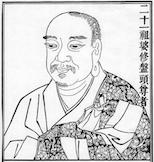Koso Wasan 16
Vasubandhu, author of the Treatise, took refuge
In the unhindered light with the mind that is single;
He teaches that by entrusting ourselves to the Vow's power,
We wil reach the fulfilled land.
The Mind that is Single

One of Shinran Shonin's most common themes is 'single-mindedness'. It is a theme, which has its origins in Vasubandhu's Jodo Ron and lies very much at the heart of Shinran's strong sense of identification with him. Taking his example from Vasubandhu, Shinran begins The Song of True Shinjin and the Nembutsu (shoshin-nembutsu ge) - the centre-piece of the Kyo Gyo Shin Sho - in a simlar vein, 'I take refuge in the Tathagata of Infinite Life! I take refuge in the Inconceivable Light!' (kimyo muryoju nyorai, namo fukashigi ko).
The verse at the beginning of the Jodo Ron opens with a similar refrain, 'With my whole heart I take refuge in the Tathagata of Light Shining Unhindered Throughout the Ten Quarters' (kimyo jinjippo mugeko nyorai). The two opening lines of the Shoshin Nembutsu Ge are undoubtedly intended to reflect Vasubandhu's opening line. They are written in two parts because of the meter, which is modelled on long precedent. The Twelve Adorations (junirai), attributed to Nagarjuna, perhaps provided a model for much subsequent poetry, including the Shoshin Nembutsu Ge.
The Tathagata of Light Shining Unhindered Throughout the Ten Quarters is reputed to have been a form of the nembutsu greatly admired and praised by Shinran and in the Chapter on The True Buddha and Land in the Kyo Gyo Shin Sho Shinran pins down the specfic title of the Buddha of his focus as 'Tathagata of Inconceivable Light'. The aspect of Tathata which most impressed Shinran and, before him T'an-luan, was light; the wisdom which pervades all things is the form taken by the light.
Although infinite light is a name used in the Larger Sutra this emphasis on light finds its origin most clearly in Vasubandhu. It was developed by T'an-luan and cherished above all other qualities of 'that which pervades all things' by Shinran. To my mind it is a most attractive and compelling emphasis. Among many reasons, probably the most significant at a spiritual level is the contrast between the effulgence of the deep wisdom at the heart of things and the evanescent and shadowy nature of our own existence. The fact that both Vasubandhu and Shinran relish the unhindered nature of this effulgence is also deeply significant because it signifies the fact that we do not become Buddha, but Buddha becomes us: filling our hearts with his irresistible wisdom and joy, and surrounding us in his embrace - just as we are; revealing us as we are, and, yet, embracing us in his pure compassion.
Still more noteworthy is the inspiration Shinran draws from the phrase Vasubandhu uses in the context of taking refuge in the Tathagata of Light: 'With my whole heart'. The term that Shinran uses more than any other for the focus of his sense of the awakening that is at the heart of the Pure Land way - shraddha, confident trust, or faith - is shinjin or 'wholehearted faith', or 'wholehearted trust'. In faith there is no duplicity, it is single-minded, it is wholehearted and unequivocal.
If we look at the passages from the Pure Land Masters, which Shinran uses in his Kyo Gyo Shin Sho, we are often struck by the insistence on the part of most of them, but especially Shan-tao, that the Pure Land way involves an intense concentration of the will; an effort to focus exclusively on Amida Buddha. A clear illustration of this characteristic in Shan-tao's thinking can be found in his Allegory of Two Rivers and a White Path. He suggests that we must reliquish all attachments, distractions, fears and temptations and focus our minds only upon the goal - Amida Buddha and the Pure Land. Shan-tao also describes the intensely focussed practice of repentance in the Pure Land Way; an activity so concentrated that one weeps tears of blood.
Shinran, on the other hand, is a man at peace with himself, in spite of his self-deprecation. He is a man of gentle heart and his single-mindedness does not seem to have the ferocity that appears to be present in the writings of his predecessors. As we come to appreciate this, it becomes clear that Shinran knows what it is to be 'embraced and not forsaken'.
What happens for Shinran is that the light in which he bathes is the light that gives form to Amida Buddha. Shinran's 'single-mindedness' is the single ultimate reality, the dharma body itself. The source at the heart of reality, it fills the universe with its effulgence. There just is no other light; and it is the dharma body itself which is single-minded in calling to Shinran in the Primal Vow, the Name, and allowing him to trust it.